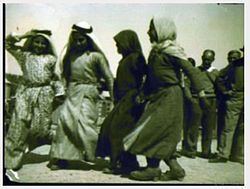Arabic أبو شوشة Population 835 (1948) | Name meaning The father of the Tuft Palestine grid 163/224 Area 8,960 dunams9 km² | |
 | ||
Abu Shusha (Arabic: أبو شوشة) was a Palestinian Arab village in the Haifa Subdistrict. It was depopulated during the 1947–48 Civil War in Mandatory Palestine on 9 April 1948 during the Battle of Mishmar HaEmek.
Contents
History
The village was located just west of Tall Abu Shusha, which recent examination shows may date from the Early Bronze Age. It has also been suggested as the location of the Roman town of Gaba Hippeon, founded in the year 61 BCE, by the Roman governor of Syria, L. Marcius Philippus. It was an episcopal see in the fifth-sixth centuries, and ceramics from the Byzantine era have been found here.
Ottoman era
In 1870 Victor Guérin described it as a small village. The slopes of the hill were covered with many piles of overturned materials from buildings, and on the highest point was the remains of an old tower.
In 1882, the Palestine Exploration Fund's Survey of Western Palestine (SWP) described "a little hamlet on the edge of the plain, with a spring to the east."
British Mandate era
In the British Mandate of Palestine period, in the 1922 census of Palestine Abu Shusheh had a population of 12; all Muslims, increasing sharply in the 1931 census when it was counted with Esh Shuqeirat and Arab el Saayda, to 831; still all Muslim, in a total of 155 houses.
In 1926 a small group of Jews from the Hashomer Hatzair movement settled in a caravanserai located on Tell Abu Shusha, before they moved to a location a few hundred yards south and establish Mishmar HaEmek.
In 1945 Abu Shusha had a population of 720, all Muslims, with a total of 8,960 dunams of land. Of this, 931 dunums were plantations or irrigable land, 4,939 were for cereals, while 3,090 dunams were classified as uncultivable land.
In 1940s a resident called Salim Ibn Hussein moved to Syria and returned in 1947, infused with Arab nationalism and led the armed guard of Abu Shusha during the 1947–1948 Civil War in Mandatory Palestine.
1948, aftermath
On 5 April 1948, the Haganah General Staff (HGS) instructed the Golani Brigade: "You must tell the following villages ... that we cannot assure their safety and security, and that they must evacuate forthwith." Among the four villages were Abu Shusha, Daliyat al-Rawha' and Al-Rihaniyya. According to Ben-Gurion, a delegation of Mishmar HaEmek leaders came to him on the 8th or 9 April, and told him that "it was imperative to expel the Arabs [in the area] and to burn the villages."
By the 11 April, the village was empty, and 1 Battalion in the Palmah blew up 30 houses in Al-Kafrayn and Abu Shusha in order to block the return of the villagers.
In 1992, Walid Khalidi described the area: "The only remaining sign of the village is the debris of houses, overgrown with cactuses. The grain mill is gone. On the hilly lands around the site, olive trees grow in a fenced-in area that serves as a pasture. The adjacent lands in Marj ibn Amir are planted in various crops, especially cotton."
Two village histories have been written about Abu Shusha and the Arab Turkoman; one in 1987 by Alya Khatib, and one in 1999 by Faisal al-Shuqayrat.
